The Northern Weekly Salvo
Incorporating Slaithwaite Review of Books, Weekly Notices, Sectional Appendices, Tunnel Gazers’ Gazette etc. Descendant of Teddy Ashton’s Northern Weekly and Th’Bowtun Loominary
Published at 109 Harpers Lane Bolton BL1 6HU email: paul.salveson@myphone.coop
Publications website: www.lancashireloominary.co.uk
No. 302 March 30th 2022
Salveson’s half-nakedly political digest of railways, tripe and secessionist nonsense from Up North. Sometimes weekly, usually not; definitely Northern.
General gossips
So much for the misplaced optimism of the last Salvo, when the prospect of war in Ukraine was dismissed as ‘unlikely’. The situation deteriorates by the day, with horrendous scenes that defy justification or comprehension. We bandy terms like ‘war criminal’ around far too easily (Blair, for all his faults and mistakes, wasn’t one). Putin very clearly is and deserves to be called to full account. It’s a situation in which we are far from being helpless spectators. Sending money to the many charities providing support in Ukraine is the most obvious. A few friends are looking at making their homes suitable for Ukrainian guests; there is scope for using railway property to provide support services.
Meanwhile Rishi Sunak has delivered his budget. I’m certainly not the only one to think it is one of the worst Tory budgets in living memory and completely flies in the face of any ideas of reducing car dependency and promoting public transport. He even had the effrontery to be photographed filling up his car at a petrol station! And where is Labour? They actually supported the 5p per litre cut. It’s unclear from the Lib Dem’s response whether they support it or don’t, or would like a bigger cut.

It was left to the Green Party to point out that it makes a mockery of any attempt to address climate change. Their co-leader Adrian Ramsay said: “We absolutely know people need help right now – but cuts to fuel duty aren’t targeted to support the poorest and the greatest numbers of people. They’re not going to fix the cost of living crisis. Research shows such a cut would mainly benefit the richest while doing little or nothing to help people on the lowest incomes. It is also worth noting that prices at the pumps have risen by no more than inflation since 2011, and since March 2021 have increased by 35% compared to a 275% increase in the gas retail price over the same period. Faced with a climate emergency and the need for a rapid transition away from fossil fuels, we also need to acknowledge that now is not the time to cut fuel duty. It is really disappointing to see Labour has jumped on this particular bandwagon.”
Next week is the funeral of my colleague and friend Philip Jenkinson. I’ll do a longer tribute to The Curmudgeonly Tyke in the next Salvo but it should be said here that without Phil’s assiduous, often truculent, behind-the-scenes effort, community rail would never have happened.
Meanwhile, Bolton Council is in turmoil (again). The causus bellum is interesting though. With a bit of prompting from certain quarters, the Council decided it would be a good idea to bid for the ‘Great British Railways’ HQ, following Grant Shapps’ idea to ask for competive bids for its location. Maybe they couldn’t think of anywhere. Bolton has some claim to having a railway heritage and certainly qualifies as a town in need of ‘levelling up’. Within Bolton borough sits Horwich, once the engineering centre for the Lancashire and Yorkshire Railway; the Bolton and Leigh Railway, opened in 1828, was the first public railway in Lancashire. What has caused ructions is Bolton Council’s bid which proposes having the HQ in central Bolton – not Horwich. This has resulted in the delicate political balance on the Council being upset. Some members of ‘hyper-local’ party Horwich and Blackrod First, in alliance with the ruling Tories, think it should be in Horwich. They point to Horwich’s railway heritage and availability of land on the former Loco Works site which could form an ideal location for the GBR HQ. One local councillor angrily suggested that they would withdraw support from Bolton’s bid and send an irate letter to Mr Shapps. Things took a further turn when one of the leading members of the hyper-local party announced her resignation in view of its petulant attitude and now sits on the Tory benches. Whatever next? Be interesting to see if Bolton gets short-listed. My money, putting aside local loyalty, is on Doncaster.
A Lancashire Ukrainian Community
As we watch in horror the events unfolding in Ukraine, one part of the Bolton ‘family’ has particular reason to pray for an end to Russia’s war. Bolton has a well-established Ukrainian community which is working with its neighbours as well as Ukrainian groups across the country to help their brothers and sisters, many of whom have either had to flee their country or are facing relentless bombardment.
Bolton’s Ukrainian community took shape after the Second World War. Ukraine had endured immense suffering under Stalin’s rule as boss of the Soviet Union. During the early 1930s the eastern part of Ukraine
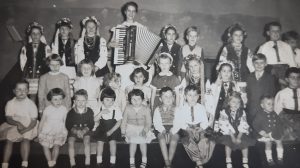
endured a calamitous famine which led to the deaths of between four and seven million people. Stalin sat back and allowed it to happen: it was a man-made catastrophe. What Ukrainians call ‘The Holodomor’ – death by starvation – is etched deeply in the minds of present generations of Ukrainians, in much the same way that the Irish Famine of the 1840s continues to be recalled with deep sorrow and anger by Irish people.
Bolton-born and bred Yaroslaw Tymchyshyn is chairman of the Bolton branch of the Association of Ukrainians in Great Britain. His father, along with thousands more Ukrainians, arrived in Britain after the Second World War hoping for a better life. Many settled in Bolton, where there was a labour shortage in the cotton industry and coal mines. Several of the men got jobs at Agrecroft Colliery. Yaroslaw’s father worked at Dobson and Barlow’s engineering works before joining Bolton Corporation as a bus conductor in 1953. According to Yaroslaw, he got the job because he was good at Maths!
“A branch of the Association of Ukrainians in Great Britain was formed in 1948 – it was one of the first in the country,” said Yaroslaw. “There had been an earlier influx of Ukrainians into Manchester, at the end of the 19th century, but it was only really in the 1940s that the flow became significant.” Alongside the association, a youth group was also established.
The association raised funds to get its own cultural centre where the community’s heritage could be cherished and maintained. The first centre was on Park Road, opposite Queens Park. It opened in 1948, the first in Britain. The association ran classes in Ukrainian for the children, as well as encouraging national music and dance. Ukrainian history and culture was taught, countering the idea that Ukraine had no national identity. It soon became too small to accommodate the range of activities and sheer numbers using the centre. The Saturday School, which focused on language teaching, reached 93 pupils, boys and girls. Some delightful photos have survived of children in traditional Ukrainian costume.
The vast majority of the Ukrainian community are Roman Catholics. In the early years, mass, delivered in the home language, was heard at St Patrick’s church on Great Moor Street. The community wanted to have their own place of worship and the unused All Saints church was purchased in 1967. In recent years the building has become unsafe and the Ukrainian Catholic congregation has returned to its original base, at St Patrick’s. Father Ewhen Nevesniak is the priest.
The association started looking for larger premises and in 1963 moved in to what is their current home at 99 Castle Street, in The Haulgh. The activities of the association expanded further, with the annual Easter Meal becoming a highlight of the association’s calendar. In 1967 a meeting hall was added on to the building.
The first generation of Bolton Ukrainians felt strongly about ensuring their children would get the sort of education that many of them had been denied. Most of the boys went to Thornleigh College, while those who failed the 11-plus often going to Rome to train as priests. The majority of girls went to Mount St Joseph’s, with some attending the former St Cuthbert’s School in Bolton.
There is no doubt that Bolton’s Ukrainian community has integrated well into Bolton life and this has been reciprocated by the huge outpouring of support from Bolton people in the current crisis. “Bolton Council has been amazing,” said Yaroslaw, ”it’s wonderful to see the town hall lit up in our national colours of blue and yellow, with the Ukrainian flag flying over the library. Thousands of people have been spontaneously contributing to street collections and on-line appeals.”
(This article first appeared in The Bolton News, March 16th)
What’s Your Story, Chorley?
Chorley’s annual ‘bookfest’ is a great event. It has obviously made a healthy recovery from Covid lockdown and attracted hundreds of participants last Saturday. It took place in several venues, including the Library, Ebb and Flo Bookshop and Chorley Theatre. Local MP and Speaker of the House of Commons Lindsay Hoyle spoke about his early years as a politician and his current role as speaker. He is proving to be a great ambassador for his town, and Lancashire as a whole.
I did a session on Allen Clarke’s ‘Moorlands and Memories’, focusing on the Chorley aspects of his book. His wife was a weaver at Laurence’s Mill and he wrote a poem for her called ‘A Lass Fro’ Chorlah’. The remarkable ‘Walt Whitman connection’ was very much a Chorley thing, centring on Adlington/Anderton in its later years. A key figure was Charles Sixsmith,
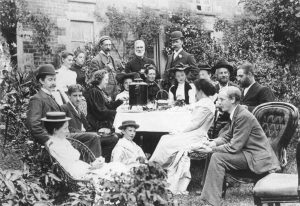
who deserves a full biography. He rose to become managing director of Bentinck Mill, Farnworth, and was for many years chairman of Chorley Rural District Council. He had a great interest in regional planning, before most people had even heard of it. He lived at ‘Brownlow’ in Anderton.
My talk was followed by John Harrison speaking about his work on ‘Co-operation in Chorley 1830-1880’. John has uncovered the remarkable history of the co-operative factory at Birkacre, which now forms part of Yarrow Country Park. The large building is long gone and the history of this project, inspired by Robert Owen, had been long-forgotten. There was a pleasing link between my talk and John’s. Allen Clarke was a key figure in the Daisy Colony, a Tolstoyan community established on the outskirts of Blackpool in the early 1900s.
Chorley is a delightful town – the market was busy and there are lots of interesting small shops. You can even get Chorley Haggis from the local butcher’s. I’m always drawn to Ebb and Flo Bookshop and Neil Hibbert’s second-hand treasure trove ‘Books and Bygones’ near the bus station. There’s usually some interesting railway books, as well as Lancashire history and lots more.
Community Rail and social enterprise – could we help deliver infrastructure services?
This paper builds on the research report published by Community Rail Network (see link below) which offers an excellent introduction to opportunities for social enterprise initiatives in a rail context. This note is more specific and hopefully complements the CRN paper.
Over the years several great ideas have been proposed for how community rail partnerships in particular (and in some cases station groups and others) can actually undertake revenue-generating activities. These have included running shops and cafes, operating community bus services and in some cases providing cleaning and light maintenance services to the railway.
These have had varying degrees of success but now seems an appropriate time to revisit some future opportunities. The creation of Great British Railways, and the strong incentives given to community rail in the Williams-Shapps Report, are the most obvious opportunities. There’s also a more worrying threat on the horizon – the risk of reductions in funding for community rail as the longer-term impact of Covid bites.

Community Rail could do a lot more, but it needs the strong support of Government and GBR, and in turn the train companies. The first issue is to look at the bigger picture, including the levelling-up agenda. Rail must be part of the local economic scene. Williams-Shapps is, again, very relevant:
“There are real opportunities for the railways to do more to support local economic growth, such as encouraging and supporting small independent retailers on the rail estate. This could extend more widely, with greater emphasis on place and social value. Priorities will differ across the network: in rural areas, community rail partnerships can provide social connections to tackle loneliness, whilst easy connections to our national landscapes can improve health and wellbeing. Reusing existing rail buildings for services such as training, community hubs and education, as Network Rail has already done in Bolton, could reduce costs for the voluntary sector and improve services for local residents.” (Great British Railways: The Williams-Shapps Plan for Rail, 2021 15 p.44)
But it could go further and start delivering some services which are currently provided on a contract basis to train operators or Network Rail, such as station cleaning and maintenance, building refurbishment and restoration and feeder bus services, bike hire and other initiatives. A final quote from Williams-Shapps seems relevant:
“New, locally-led innovation schemes will unlock smarter working and support growth. To achieve real change, there needs to be renewed emphasis on locally-led innovation and new ways of working. Those who work on the railways should be able to suggest and lead innovation in their workplaces or local network. Great British Railways will support this, through greater adoption of design sprints and competitions to identify and solve challenges at pace locally and regionally. Targeted partnerships between Great British Railways, its partners and other transport authorities, investors and start-ups will enable collaboration between the public and private sectors to push innovative solutions forward. Best practice will be shared across the sector.” (Plan for Rail, 2021 s. 49, p.83)
What do we mean by ‘locally-led innovation schemes’? It could mean many different things but one particular area of potential is in relatively low-cost infrastructure work. At the most basic, it could include cleaning and light maintenance, including putting up posters cases, small repair jobs, paintwork and the like. But it could go further and include larger refurbishment works such as bringing derelict buildings back to life.
There are many good reasons for this. The experience of many CRPs which have pulled in funding for station refurbishments hasn’t always been great. Sometimes they find the work done is of poor quality and they have had little or no involvement in the detailed specification.
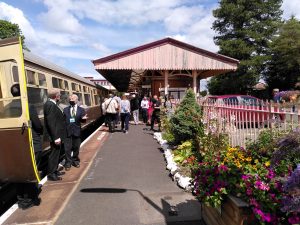
At the same time, some contractors parachute in, and out – often from distant locations using staff with no stake in the area. Surely, if the expertise was there, there would be gains to the local economy, to local businesses and would reduce environmentally-damaging road journeys?
Does community rail currently have the capacity to do these things? Mostly, not – at present. Some CRPs could probably take on cleaning and light maintenance for specified stations, including ‘winterisation’. However, there are real opportunities for something bigger, if DfT and Network Rail/GBR was willing to really engage and offer initial funding support. In the longer term, costs could actually come down and quality of work go up.
As noted above, the experience of community rail groups with building contractors is patchy and generally not good. My suggestion is for Network Rail/GBR and a relevant TOC to work with two or three CRPs in a particular area or region to actually create a social enterprise, owned by the CRPs, which could undertake a range of work. This could evolve over time.
There are many ways it could work but the point is to ensure:
- Good quality work at a sensible price
- Using local expertise
- Offering training opportunities for young people
- Keeping investment within the local community
- Being accountable to the relevant CRPs as well as train operators and Network Rail
Let’s call it ‘Community Rail Infrastructure Services Ltd.’ (CRIS) for now. It could be regionally-based and in time there could be several CRISs, each owned by the relevant CRP/s in the area. A pilot project could be based on one region, let’s say the North West where there are several well-established CRPs and Network Rail has a record of working positively with CRPs, as well as the TOCs (Northern, TPE, Avanti WC).
CRIS should be set up as a social enterprise, probably using the CIC model. It need not have a large staffing base initially, but would certainly require a core of paid staff with a range of business and construction skills. CRIS (NW) would identify local craftspeople in the area who can offer good quality work at a competitive price. This could include architects and design companies, joiners, plumbers, electricians, painters and general building companies. It could also take on the job of letting premises for community groups. Again, the experience of CRPs with letting agents is generally negative.
Network Rail could look at seconding some staff, including apprentices and graduate trainees, to the company. Initially, Network Rail could look at seconding a senior manager, possibly coming up to retirement who is looking for a fresh challenge and has the diversity of skills and experience which CRIS would require.
The board of CRIS should comprise representatives of the relevant CRPs, Network Rail (and GBR in the future) and train companies. It could also include representatives of FE colleges given the emphasis on apprenticeships and training, linking in to FE colleges’ building and engineering courses.
Could it work? I think it could, but it would need engagement at a senior level in DfT, Network Rail and the GBR Transition Team to make it happen. I suspect that some CRPs would be very interested, but maybe not all. A regional trial would make sense.
St Helens: a walk along the cut
It’s a Lancashire town which I don’t know very well. It was famous for its glass industry and was also a mining centre in its time. I can remember Bold, Sutton Manor and Cronton collieries still working in the 1980s. The main objective of the excursion was to visit the new, community-owned, bookshop: Bookstart. It’s a great shop, with a cafe as well. Right in the town centre, on Bridge Street; it had a nice buzz to it in a town that is clearly struggling. But there’s a lot to this town and a day trip should include the Pilkington’s glass museum, which is close to the station. You don’t have to pay the entrance fee to use the cafe, bookshop and visit the art gallery.
I have to confess I didn’t get to the Transport Museum. Partly lack of time but there are only so many double-decker buses I’d want to inspect. Maybe it should do more to promote the social aspect of
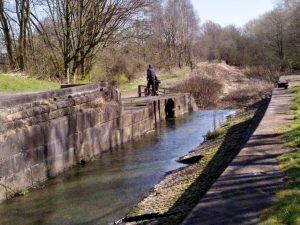
transport. But I promise I’ll go back and visit. We did a very pleasant walk along parts of the old canal network, starting off at Blackbrook and doing a circuit that took us, unintentionally, to Peasley Cross where bits of the old St Helens and Runcorn Gap Railway – a very early railway dating back to 1833 – are still visible. Odd that the track is still in place. We then hopped on a bus into town and walked back via the Sankey Canal almost to our starting point, picking up a bus for the last mile. The canal is of great historic importance, dating back to 1759, and is the subject of a ‘world heritage’ bid. I hope it succeeds, it will help put St Helens on the map.
Trespassers to be celebrated
On April 24th 1932, 600 young men and women set off from Bowden Bridge in Hayfield to walk illegally on Kinder Scout to campaign for better access rights. Some fought battles with the gamekeepers while on Kinder, while five of the Trespassers were subsequently imprisoned. The last of the group died in 2019, aged 103. On 21st April, the Working Class Movement Library is hosting a celebratory symposium (in person and online streaming). A panel of researchers, writers and activists will be exploring the resonance and legacy of the ‘Red Politics of the Mass Trespass’ in the 1930s for the Green Politics of the climate emergency and land justice movements of the 2020s. Details can be found on the WCML’s website: https://wcml.org.uk/whats-on/events/trespassers-will-be-celebrated–symposium-marking-the-anniversary-of-the-mass-trespass/
On the Saturday, April 23rd, the Ramblers are organising a walk up to Kinder. It’s a 10 mile circular walk. Full details are here: https://www.meetup.com/Manchester-Weekend-Walkers/events/283893951/
The walk allows us to pay tribute to those who were willing to risk so much to allow others to enjoy the open countryside, as we follow their original route. It includes a long, steep climb and some open, exposed areas, so is only suitable for anyone who is confident of their fitness.
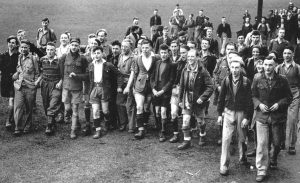
Meet Point near the ticket barriers, or on the platform at Piccadilly station for the 09:20 train (final destination New Mills Central). At New Mills Central, walk up the road to the bus station and catch the 358 to Hayfield at 10:18. Alternatively, board the 358 in Stockport at 09:35, or meet the group on the train or at the bus station car park in Hayfield. Please note, however, that because of the Trespass events, parking in Hayfield may be difficult.
Railways and Railwaymen of Turton
I had an enjoyable evening with Turton Local History Society last week, talking about ‘railways and railwaymen of Turton’. Apologies for the gender bias there, I did mention the wonderful Gladys, former station-mistress at Bromley Cross in the early 1980s. Here’s a short excerpt from my ‘railway’ chapter of Moorlands, Memories and Reflections which paid tribute to some of the characters I knew as a young lad:
In the summer of 1966 I got to know the regular signalmen at both

Entwistle and Walton’s Siding. Pat Hatzer and Frank Carroll were the ‘regular men’ at Entwistle though at some point Frank moved ‘up’, at least in geographical terms, to Walton’s. Both were very kind and friendly towards me, but they were as different as chalk and cheese and never really got on with each other. Interestingly, they were both from Catholic backgrounds, Pat being from a Polish family and Frank being Irish by origin. As a ‘Thornleigh boy’ in my mid-teens I was the acceptable face of train-spotting – or ‘railway enthusiasm’ as we preferred to call it. The Hatzers lived in Entwistle and Pat was part of a larger family, with children who have stayed in the area. I would either cycle up to Entwistle or catch the train, often with my friend Steve. We would climb up the signalbox steps to a warm welcome and cup of tea.
Those calm summer evenings were idyllic. By 1966 there were few steam-hauled freights over the route but two regular, heavily-loaded, trains ran in the evening. These were Brindle Heath (Salford) to Carlisle, usually followed about an hour later by the Ancoats – Carlisle. Whilst the ‘Brindle Heath’ could be anything from an LMS ‘Black 5’ to a ‘Britannia’ pacific, the ‘Ancoats’ was nearly always a Carlisle Kingmoor-based class 9F 2-10-0, the most powerful locos in general use on BR by then.
In late June, if you were lucky, it was sometimes still light enough to photograph ‘The Brindle Heath’ but it was always dark by the time ‘The Ancoats’ came up. On occasion, you could hear it coming out of Bolton and hitting the climb past Astley Bridge Junction. It could be fifteen minutes before it stormed through Entwistle, but what a sight – and sound – it made.
Of the two signalmen, Frank was the greater conversationalist. He
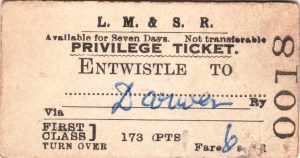
would regale us with tales of his foreign travels using his BR passes, to places such as Constantinople, to inspect Byzantine treasures. He claimed to be from a strong Irish republican family with a father who had fought in the Dublin Easter Rising of 1916, alongside Patrick Pearse in the beleaguered GPO building. Whether he did or not I don’t know but Frank could certainly tell a good tale.
When Frank moved to Walton’s Siding box, possibly to escape from having to engage with Pat at the change of shift, his eccentricities became further pronounced. He lived in Collyhurst, a mile or so out of Manchester. Travelling to and fro was onerous and difficult so during the summer months he set up camp close to the signalbox and lived the life of a hermit. Another feature of Frank’s time at Walton’s Siding were his culinary habits. He would make a huge vat of soup at the beginning of the week and live off it until the weekend. When he was on nights, and traffic was light, he would nod off in his easychair and hope he would hear the ‘call attention’ bell from Entwistle box. After ‘The Ancoats’ had passed there was usually no other train until about 4 a.m. – the famous (in Bolton railway circles at any rate) ‘Colne Papers’.
This legendary train took newspapers from Manchester to East Lancashire, It would load up on Manchester Victoria’s platform 11
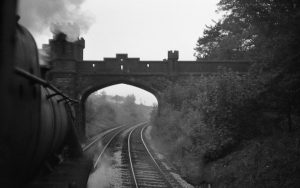
Middle (the longest platform in the world), with consignments from the Manchester presses for Bolton, Darwen, Blackburn, Accrington, Burnley, Nelson and Colne. It departed on the dot at 3.45 a.m. For many years it was a Bolton ‘job’, with driver, fireman, guard and loco from Bolton. It was one of the shorter newspaper trains, compared with the heavy Glasgow and Newcastle trains, but it was very tightly timed. Bolton loco shed was very much a freight depot and the opportunities to run fast were limited to the occasional ‘special’ and – ‘The Colne Papers’, usually pronounced ‘Ceawn Papers’ in Boltonese.
The first part of the job was in effect the ‘tail end’ of a working that entailed signing on mid-evening and working a parcels train from Bolton to Stockport. The loco then went to Red Bank carriage sidings to collect the three or vans for the Colne train. At about 3.30 it would get the signal to drop down to Victoria to load up. The timing to Bolton was 15 minutes, faster than any passenger train. It was allowed a few minutes at Bolton to change crews and unload the bundles of newspapers. The new crew – Bolton men again – took over for the run through to Colne, returning ‘light engine’ to Bolton. A few times I rode on the footplate with the first part of the job – the Stockport parcels and then from Victoria to Bolton. It was always a lively run with drivers determined to beat the fast timing and get to Bolton early.
Grand day out in Haltwhistle
I was recently privileged to be a guest of Tyne Valley Community Rail Partnership. It covers the historic – and still very important – route between Carlisle and Newcastle, via Haltwhsitle and Hexham. I visited on one of those lovely Spring days and was met by Fiona, Julie, Colin and Malcolm at Haltwhistle. 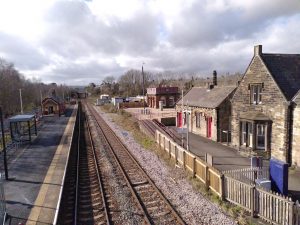 What a transformation at this historic station! Buildings –including water tower, booking office, waiting rooms and signalbox –have been brought back into use, gardens created and a general sense of ‘well-being’ (a much over-used term I know) created. Haltwhistle itself is a delightful town. A real ‘town’ rather than village, with pubs, shops and library. The location, along the River Tyne, couldn’t be better. The station acts as a barrier between town and river; the south side of the tracks take you down to a magnificent bridge across the river and out to open country. Only wish I’d had more time to explore, but there’s always a second time. Thank to my hosts for their company, conversation and lunch!
What a transformation at this historic station! Buildings –including water tower, booking office, waiting rooms and signalbox –have been brought back into use, gardens created and a general sense of ‘well-being’ (a much over-used term I know) created. Haltwhistle itself is a delightful town. A real ‘town’ rather than village, with pubs, shops and library. The location, along the River Tyne, couldn’t be better. The station acts as a barrier between town and river; the south side of the tracks take you down to a magnificent bridge across the river and out to open country. Only wish I’d had more time to explore, but there’s always a second time. Thank to my hosts for their company, conversation and lunch!
Lancashire Loominary publications : Spring Sale for readers
- ALLEN CLARKE: Lancashire’s Romantic Radical £9.99 (normally £18.99)
- Moorlands, Memories and Reflections £15.00 (£21.00)
- The Works (novel set in Horwich Loco Works) £6 (£12.99)
- With Walt Whitman in Bolton £6 (9.99)
See www.lancashireloominary.co.uk for full details of the books (ignore the prices shown and use the above – add total of £4 per order for post and packing in UK)
Talks, walks and meanderings
Following the ‘official’ end of the Pandemic, I’ve been getting a number of invitations to give talks on various topics. Recent talks have included ‘Railways and Railwaymen of Turton’ (see above), ‘Moorlands, Memories and Reflections’ for What’s Your Story, Chorley? and ‘Railways and Communities: Blackrod and Horwich’, for Blackrod Local History Society. A few people (well, one) asked what the other topics are, so here you are:
- The Lancashire Dialect Writing tradition
- The Railways of the North: yesterday, today and tomorrow
- Allen Clarke (1863-1935) Lancashire’s Romantic Radical
- The Winter Hill Mass Trespass of 1896
- The Rise of Socialism and Co-operation in the North
- The Clarion Cycling Clubs and their Club Houses
- Walt Whitman and his Lancashire Friends
- Forgotten Railways of Lancashire
- Banishing Beeching: The Community Rail Movement
- Railways, Railwaymen and Literature
I charge fees that are affordable to the organisation concerned, to fit their budget – so by negotiaton. An average fee is in the region of £40-£50, all in.
My preferred geographical location is within 25 miles of Bolton, ideally by train/bus or bike. However, with sufficient notice I can go further afield.
Forthcoming talks include:
- ‘Railways, Railwaymen and Literature’: RCTS Carnforth, Royal Station Hotel, Wednesday April 6th at 19.00
- Socialism with a Northern Accent’ Stretford Probus Club, Monday May 23rd (morning event)
- ‘Allen Clarke’s Bolton’, Wednesday May 15th, Friends of Smithills Hall, 19.30
Lancashire Authors’ Association – Seeking a Secretary
This year, 2022, is an exciting time for the Lancashire Authors’ Association. We are joining with the University of Bolton and The Lancashire Society to make an application for a Heritage Lottery Fund Grant, to publicise the wonderful collection of Lancashire Literature and History. A collection which has been built up over the past 100 years and is now housed in the University of Bolton Library.
From June of this year, our present secretary is unable to continue in the post so we are looking for someone to take on the role of Secretary to the Association. Are you that person?
If you are recently retired and have experience of this type of work, with an interest in Lancashire Literature and History, this could be exactly the right, new hobby for you! This is a voluntary position. You do not have to be a writer although writers are always welcome.
For further information about the association and this role please see our website: www.lancashireauthorsassociation.co.uk or contact Olive by e-mail: ojriley@postmaster.co.uk
Heart of Wales Line Development Company recruits
The HoWL Devco – the community rail partnership for the Shrewsbury – Swansea Line, is keen to extend the range of its commercial activity and has decided to create the post of Development Manager, to generate income streams. Details: admin@devco.org.uk (note the official deadline has passed but it may be still worth expressing interest).
And finally………
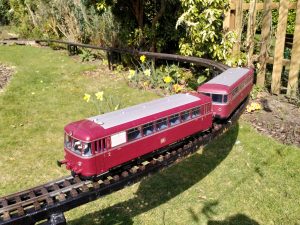
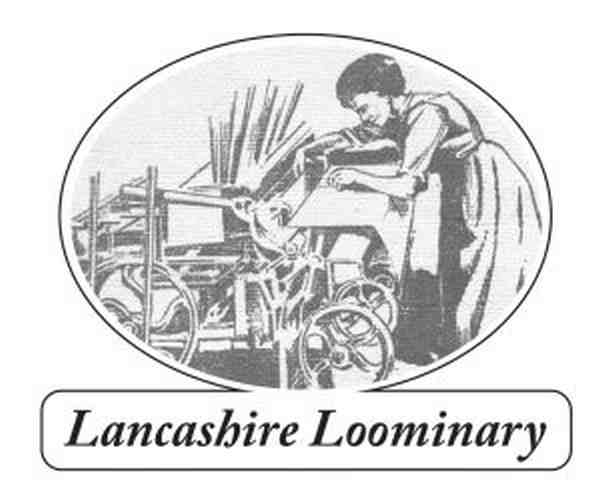
6 replies on “Northern Weekly Salvo 302”
Not sure I’d let Tony Blair off so easily, though clearly not as wicked as Putin, though it’s interesting to contrast the reaction to Joe Biden’s gaffe about regime change with the tacit acceptance of it in Iraq. Turning to the Budget – yes, a disgrace almost as bad as 1981. I just hope Ukraine doesn’t crowd out the political repurcussions for it & much else besides, notably ‘partygate’. Nothing in the budget about levelling-up, net zero let alone what it should have concentrated on – help for those who most need it. And by the way Sunak had borrowed a car from a Sainsbury’s employee for the ‘photo opportunity’. Millionaires with billionaire wives don’t drive Kia hatchbacks.
Whilst lamenting the terrible situation in Ukraine, let’s give full credit to Ukrainian Railways for keeping the trains moving and getting so many people out of the war zones.
There was a Ukrainian Co-operative Society Limited formed in Rochdale about 1960 and they had a shop in Milnrow Road for a number of years. Rochdale is twinned with Lviv; the bridge over the river by the Municipal Buildings is named “The Lviv Bridge”. In the Memorial Gardens is a stone tablet commemoration the Holodomor — Stalin’s famine. The church where my mum and dad were married in 1935 is now the Ukrainian Catholic Church. Followers of the Ukrainian Orthodox Church have a small meeting room as well. The Ukrainians had a strong presence in the local Chess League. I only visited Ukraine once, in the year of the Hale Bopp comet, I think 1997. At that time it was a desperately poor country but everyone we met especially the younger people were extremely friendly and optimistic. Parties of young Ukrainian steam locomotive fans have several times visited the Worth Valley Railway. What is happening is a desperate tragedy.
Thanks Richard, that’s very interesting. Will feature it in next Salvo
Paul
I am pleased to hear about Haltwhistle. Back in the late 80s when I was RR NE Marketing Manager I looked after all the property from the business angle. One day I ha a visit from a very senior roads engineer to talk about the A69 Haltwhistle “bypass” where at that time their plan was to drive the road straight through the station and along the cutting to west which would have required the line to be singled. It would also have required the demolition of the bulk of the listed station with only the water tower surviving. Access to the platforms was to be via a footbridge over said new section of the A69.
Suffice to say I disagreed with this proposal, also knowing that the community were not keen on it and the (I think by then retired) traffic manager lived in the station house. We had discussions about it all being government funds which I found rather amusing as it never flows the other way. It seems mad thinking about it now, but this is only about 15 years after the main Edinburgh – Perth line through Glenfarg was shut to build the M90 on bits of it.
I point blank refused to take forward his suggestion and fortunately it never came up again and a more realistic route was chosen.
Many thanks Paul- fascinating range of material as always.